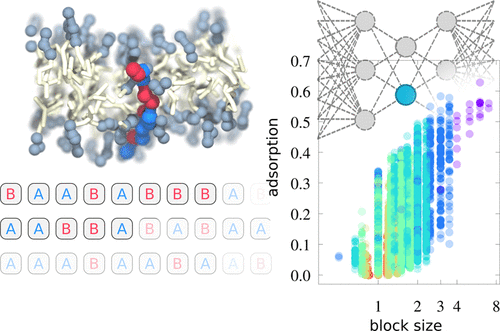当前位置:
X-MOL 学术
›
ACS Macro Lett.
›
论文详情
Our official English website, www.x-mol.net, welcomes your
feedback! (Note: you will need to create a separate account there.)
Decoding Interaction Patterns from the Chemical Sequence of Polymers Using Neural Networks
ACS Macro Letters ( IF 5.1 ) Pub Date : 2021-10-11 , DOI: 10.1021/acsmacrolett.1c00325 Marco Werner 1
ACS Macro Letters ( IF 5.1 ) Pub Date : 2021-10-11 , DOI: 10.1021/acsmacrolett.1c00325 Marco Werner 1
Affiliation

|
The relation between chemical sequences and the properties of polymers is considered using artificial neural networks with a low-dimensional bottleneck layer of neurons. These encoder–decoder architectures may compress the input information into a meaningful set of physical variables that describe the correlation between distinct types of data. In this work, neural networks were trained to translate a sequence of hydrophilic and hydrophobic segments into the effective free energy landscape of a copolymer interacting with a lipid membrane. The training data were obtained by the sampling of coarse-grained polymer conformations in a given membrane density field. Neural networks that were split into separate channels have learned to decompose the free energy into independent components that are explainable by known concepts from polymer physics. The semantic information in the hidden layers was employed to predict polymer translocation events through a membrane for a more detailed dynamic model via a transfer learning procedure. The search for minimal translocation times in the compressed chemical space underlined that nontrivial sequence motifs may lead to optimal properties.
中文翻译:

使用神经网络从聚合物的化学序列中解码相互作用模式
使用具有低维神经元瓶颈层的人工神经网络来考虑化学序列与聚合物性质之间的关系。这些编码器-解码器架构可以将输入信息压缩成一组有意义的物理变量,描述不同类型数据之间的相关性。在这项工作中,神经网络被训练以将一系列亲水和疏水片段转化为与脂质膜相互作用的共聚物的有效自由能景观。训练数据是通过在给定的膜密度场中对粗粒聚合物构象进行采样获得的。被分成不同通道的神经网络已经学会将自由能分解成独立的成分,这些成分可以用聚合物物理学中的已知概念来解释。隐藏层中的语义信息用于预测聚合物通过膜的易位事件,以通过迁移学习程序获得更详细的动态模型。在压缩的化学空间中寻找最小易位时间强调了非平凡的序列基序可能导致最佳特性。
更新日期:2021-11-16
中文翻译:

使用神经网络从聚合物的化学序列中解码相互作用模式
使用具有低维神经元瓶颈层的人工神经网络来考虑化学序列与聚合物性质之间的关系。这些编码器-解码器架构可以将输入信息压缩成一组有意义的物理变量,描述不同类型数据之间的相关性。在这项工作中,神经网络被训练以将一系列亲水和疏水片段转化为与脂质膜相互作用的共聚物的有效自由能景观。训练数据是通过在给定的膜密度场中对粗粒聚合物构象进行采样获得的。被分成不同通道的神经网络已经学会将自由能分解成独立的成分,这些成分可以用聚合物物理学中的已知概念来解释。隐藏层中的语义信息用于预测聚合物通过膜的易位事件,以通过迁移学习程序获得更详细的动态模型。在压缩的化学空间中寻找最小易位时间强调了非平凡的序列基序可能导致最佳特性。











































 京公网安备 11010802027423号
京公网安备 11010802027423号